All great discoveries start as an idea in someone’s head and it requires a lot of time, energy, perseverance and help to actually get it into the hands of someone who will benefit from it. First, you have to convince yourself that it’s a good idea (not always as easy as you would think… the inner self critic can be a big hurdle). Then you have to convince other people that it is a good idea. Without a team behind you and a significant financial investment, a discovery in the life sciences is likely to never see the light of day. Additionally, building infrastructure and the high-end instrumentation required are often cost prohibitive.
Here at Austin Community College’s Bioscience Incubator, we provide affordable lab space to startups, with access to extensive equipment and instrumentation as a way of lowering the barrier to these great ideas. However, ABI has only been in existence for 3.5 years. Before ACC took the bold leap to build such a valuable resource for the Austin life sciences community, there was very little support available for biotech entrepreneurs. So, how did companies do it before the Bioscience Incubator existed? Were they doing this work in their garage? Did they spend their life savings on ideas that may not have been that great? Or did they just abandon the whole idea? Take a listen to the founder of local biotech company, Tevido Biodevices, as she retraces the path to now.
Laura Bosworth is smart, resourceful, capable, nimble, and she has landed in a business that is offering a fantastic product called TruPigment catering to people with areas of skin lacking in pigment. Not only did she rent a building and build a lab, but her process required that she upgrade the capabilities of the lab to include a cleanroom to accommodate processing of skin from people who have diseases like vitiligo. Laura and her team (that included people that she hired out of the ACC Biotech program) process portions of the patient’s skin that is not affected by the disease and provides those cells back to their doctor to re-pigment the affected areas. It sounds like science fiction, but those are the kinds of science that are being done in the Mall. Listen to Episode 4 of Science in the Mall, Y’all for a great story of how it got done before ABI existed.
Nancy Lyon
Interim Director
Listen on your favorite platform:
Acast // SoundCloud // Spotify // iTunes // Google Play // Stitcher

